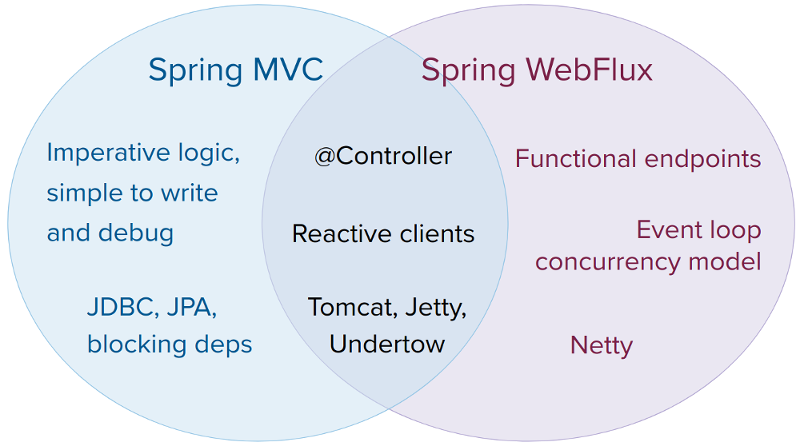这篇笔记,继续沿着 Spring Cloud Gateway,来聊一聊 WebFlux.
1. 响应式编程
优秀的系统实现,特点之一就是对于线程的控制,能够让线程专注在一件事情上,降低系统线程间切换的开销。
比如当我们发起一次耗时的 IO 操作:
String foo() {
String s = fetch_from_remote_long_long_time();
return s;
}
当前线程会阻塞,直到 IO 返回。当调用变多,就会有大量线程阻塞在这个位置,由于线程本身需要栈空间、上下文切换等操作,当面临高并发时,就会出现性能问题。
响应式编程会优化为非阻塞的过程,当前线程在请求完成后能够立刻“释放”,不会阻塞在当前位置。
举个访问 redis 的例子:
@GetMapping(value = "/test/redis")
public void testRedis() {
System.out.println("current thread: " + Thread.currentThread());
try (Jedis jedis = new Jedis("localhost", 6379)) {
jedis.auth("foobared"); // 认证密码
String value = jedis.get("hello"); // 阻塞调用
System.out.println("Got from Jedis: " + value + " in thread: " + Thread.currentThread());
}
RedisClient client = RedisClient.create("redis://:foobared@localhost:6379");
RedisReactiveCommands<String, String> reactiveCommands = client.connect().reactive();
Mono<String> valueMono = reactiveCommands.get("hello");
valueMono.subscribe(value -> System.out.println("Got from Reactive: " + value + " in thread: " + Thread.currentThread()));
}
输出:
current thread: Thread[reactor-http-nio-3,5,main]
Got from Jedis: world in thread: Thread[reactor-http-nio-3,5,main]
Got from Reactive: world in thread: Thread[lettuce-nioEventLoop-8-1,5,main]
可以看到最大的区别,就是返回结果执行线程不同。原来的线程,在发起subscribe后就“释放”了。
我在看 SCG 的代码,以及使用 Reactive 时,最直观的感受就是可以更优雅地嵌入回调了,比如代码里的System.out.println。总结 Reactive 性能之所以强大,是在于线程能够专注,减少了频繁的上下文切换。
注:实际上我在实际场景里,也很少会需要用到 lettuce-core 访问 redis,这里只用来方便对比说明。
2. WebFlux、Project Reactor、ReactiveStream
ReactiveStream 是一套规范1,定义了像Publisher Subscriber Subscription Processor的接口及行为方式。
Project Reactor 是 ReactiveStream 的其中一种实现,提供了Flux Mono等定义。
WebFlux 则是基于 Project Reactor 实现了响应式 Web 框架。

SCG 里我们主要关注后两者即可。由于 WebFlux 里本身就有RouteFunction的定义,同时加上Mono Flux、subscribeOn publishOn等语法,写法跟 MVC 差别很大。对于初学者还是比较容易弄混的。接下来的章节简单梳理一下。
3. Flux Mono
package reactor.core.publisher;
public abstract class Flux<T> implements CorePublisher<T> {
package reactor.core.publisher;
public abstract class Mono<T> implements CorePublisher<T> {
package reactor.core;
public interface CorePublisher<T> extends Publisher<T> {
package org.reactivestreams;
public interface Publisher<T> {
可以看到两者都是org.reactivestreams.Publisher的一种实现,之所以需要有两种,主要是:
Flux: 流式处理,数据源产出的数据有 0~N 个Mono: 常用于返回值,比如响应式框架里@RestController注解的方法,就可以返回Mono<String>,因此用于表示 0~1 个的数据
以Flux为例,可以从已有数据创建;也可以通过程序构建,用于创建无限流。既然是流,也就有类似 java 里 Stream 的操作,比如map
Flux<String> flux1 = Flux.just("foo", "bar", "foobar");
flux1.map(s -> s.toUpperCase())
.subscribe(System.out::println);
Flux<String> flux2 = Flux.generate(
() -> 0,
(state, sink) -> {
sink.next("3 x " + state + " = " + 3*state);
if (state == 100000) sink.complete();
return state + 1;
});
flux2.subscribe(System.out::println);
比如 WebFlux 里这段DispatcherHandler的源码:
public class DispatcherHandler implements WebHandler, PreFlightRequestHandler, ApplicationContextAware {
@Override
public Mono<Void> handle(ServerWebExchange exchange) {
if (this.handlerMappings == null) {
return createNotFoundError();
}
if (CorsUtils.isPreFlightRequest(exchange.getRequest())) {
return handlePreFlight(exchange);
}
return Flux.fromIterable(this.handlerMappings)
.concatMap(mapping -> mapping.getHandler(exchange))
.next()
.switchIfEmpty(createNotFoundError())
.onErrorResume(ex -> handleResultMono(exchange, Mono.error(ex)))
.flatMap(handler -> handleRequestWith(exchange, handler));
}
concatMap的作用是将 Flux 转为 Mono,说白话就是将多个数据,转为单条数据,对应到业务效果上,就是筛选出mapping.getHandler(exchange)返回handler而不是Mono.empty()的那条。
举个例子:
Flux<Mono<String>> handlerMonos = Flux.just(
Mono.empty(),
Mono.empty(),
Mono.just("matchHandler-1"),
Mono.just("matchHandler-2")
);
Flux<String> handlerFlux = handlerMonos.concatMap(m -> m);
// concatMap: matchHandler-1
// concatMap: matchHandler-2
handlerFlux.subscribe(result -> System.out.println("concatMap: " + result));
handlerFlux.next()
.defaultIfEmpty("Error")
// next: matchHandler-1
.subscribe(result -> System.out.println("next: " + result));
4. 线程
既然非阻塞解决了当前线程阻塞的问题,那么首要的疑问,就是回调是在哪里执行的?
看个例子:
@GetMapping(value = "/test/thread")
public String testThread() {
Flux.just(1)
// .publishOn(Schedulers.parallel()) //指定在parallel线程池中执行
.map(i -> {
System.out.println("map1: " + Thread.currentThread().getName());
return i;
})
// .publishOn(Schedulers.boundedElastic()) // 指定下游的执行线程
.map(i -> {
System.out.println("map2: " + Thread.currentThread().getName());
return i;
})
// .subscribeOn(Schedulers.single())
.subscribe(i -> System.out.println("subscribe: " + Thread.currentThread().getName()));
return "success";
}
当前都是在一个线程(reactor-http-nio-x)里执行的。
如果去掉注释:
map1: custom-thread-1
map2: parallel-1
map3: boundedElastic-2
map4: boundedElastic-2
subscribe: boundedElastic-2
publishOn:对之后的算子生效,直到遇到新的publishOn subscribeOnsubscribeOn: 从流开始生效,直到遇到新的publishOn subscribeOn
就能够理解上述的输出了。
WebFlux 内置的几种线程池:
| 方法 | 用途 | 特点 |
|---|---|---|
Schedulers.parallel() |
CPU 密集型任务 | 固定线程池,线程数 = CPU 核数,避免上下文切换 |
Schedulers.immediate() |
当前线程执行 | 不切换线程,直接在调用线程上执行 |
Schedulers.newBoundedElastic(int threadCap, int queuedTaskCap, String name) |
自定义弹性线程池 | 指定最大线程数、队列任务数和线程名称前缀 |
Schedulers.single() |
所有任务共用一个线程 | 顺序执行任务,适合串行操作 |
从这里就可以看出在 reactive 对于线程的切换极其方便,同时对语义没有影响,结果保持一致。
5. ThreadLocal
讲了线程,就离不开ThreadLocal,在DolphinScheduler-2: 日志里介绍过 MDC。使用 MDC 可以更方便的追踪一个任务不同阶段的执行记录。
MDC 的实现就依赖于ThreadLocal.
对于上面的代码,如果在map方法里打印日志,肯定就会出错了。举个更简化的例子看看:
@GetMapping(value = "/test/MDC")
public String testMDCMultiThread() throws InterruptedException {
MDC.put("trace_id", "multiThread");
Flux.range(1, 3)
.map(i -> {
System.out.println("[before publishOn] " + i + " on thread: " + Thread.currentThread().getName() + ", trace_id=" + MDC.get("trace_id"));
return i;
})
.publishOn(Schedulers.boundedElastic()) // 切换线程池
.map(i -> {
System.out.println("[after publishOn] " + i + " on thread: " + Thread.currentThread().getName() + ", trace_id=" + MDC.get("trace_id"));
return i;
})
.subscribe();
System.out.println("testMDC in Thread: " + Thread.currentThread().getName());
return "testMDC";
}
通过输出可以看到在第二个doOnNext方法里,线程和trace_id都变了:
[before publishOn] 1 on thread: reactor-http-nio-3, trace_id=multiThread
[before publishOn] 2 on thread: reactor-http-nio-3, trace_id=multiThread
[before publishOn] 3 on thread: reactor-http-nio-3, trace_id=multiThread
testMDC in Thread: reactor-http-nio-3
[after publishOn] 1 on thread: boundedElastic-1, trace_id=null
[after publishOn] 2 on thread: boundedElastic-1, trace_id=null
[after publishOn] 3 on thread: boundedElastic-1, trace_id=null
怎么解决呢?
我想到的一个解法,是使用 Project Reactor 里的 context2:
Flux.range(1, 3)
.map(i -> {
System.out.println("[before publishOn] " + i + " on thread: " +
Thread.currentThread().getName() + ", trace_id=" + MDC.get("trace_id"));
return i;
})
.publishOn(Schedulers.boundedElastic())
.flatMap(i ->
Mono.deferContextual(ctx -> {
String traceId = ctx.getOrDefault("trace_id", "N/A");
MDC.put("trace_id", traceId);
System.out.println("[after publishOn] " + i + " on thread: " +
Thread.currentThread().getName() + ", trace_id=" + MDC.get("trace_id"));
MDC.clear(); // 避免污染线程池
return Mono.just(i);
})
)
.contextWrite(Context.of("trace_id", "multiThread"))
.subscribe();
代码丑陋了很多,“What Is a Good Pattern for Contextual Logging?(MDC)”3这里也提到了Context,感觉是一回事。
实际上在之前的笔记里,我发现 DolphinScheduler 手动维护MDC.put clear时,由于模块设计了几组线程池和回调,也总会有出错的地方。我觉得最好的方式,是在模块里自定义Context传递,这样最为稳妥,比如对于 Spring Cloud Gateway,可以将这类数据都写入到exchange attribute里。
进一步的,可以考虑自定义MDCAdapter的实现。
6. WebFlux 的编程模型
SCG 里用的不多,不过编程模型是 谈 WebFlux 时绕不开的,主要有两种:
- 注解式:
@RestController,这个跟 Spring MVC 很像,返回诸如Mono<String> Flux<String>的结构。 - 函数式:通过
route指定 url 和处理方法,HandlerFunction则用来接收ServerRequest,返回ServerResponse
这块实现起来偏 CRUD,主要熟悉用法即可,重点关注避免耗时操作打满 controller 线程。我把一些 demo 上传到了Microservice-Systems/webflux/.
7. 总结
目前为止,我大概接触了 3 种流模式的数据处理。
第一类最为简单,是编程语言支持的,比如 java 里的 stream,python 里的 list 等,顺序处理,重点关注其不同方法的效果就行。
第二类则是 ReactiveStream ,除了函数的效果,有了更多关注点:比如flatMap可能会并发执行,而concatMap固定单个线程执行;比如Mono.defer能够起到 lazy 的效果。
同时这里已经有点声明式语法那味了,只有subscribe之后,定义的各个方法才会真正执行。到了第三类,即大数据里的流式处理,典型的如 flink spark。类似于subscribe,只有调用execute才会生成算子拓扑图,分发任务启动,不只是线程不同,算子已经是通过 YARN K8S 部署在 Container 里了。比如在之前的笔记里,刚接触大数据时,还是非常诧异的。
回到 WebFlux,之所以有这篇笔记,也是缘于 Spring Cloud Gateway。响应式编程,相比原来性能提升有多少,我没有太多实际项目经验。不过从网关的角度,每个连接一个线程的做法,毫无疑问是不合理的。